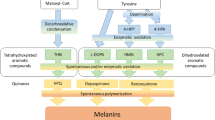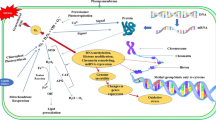Abstract
Carotenoids are naturally occurring yellow or orange pigments that serve as a protectant against photo-oxidative damages. Among the wide variety of producers, the prokaryotes generate a broad spectrum of carotenoids with diverse chemical structures that are expected to have a high potential in biotechnological applications. Bacterial carotenogenesis occurs in a constitutive or light-induced manner, which suggests the diversity of the regulatory mechanism. The mechanism for light-induced carotenoid production in non-phototrophic bacteria has been studied in detail in Myxococcus xanthus, a Gram-negative gliding bacterium. The complicated mechanism involves the activation of an extracytoplasmic function (ECF) sigma factor (CarQ), which leads to the sequestration of a MerR family transcriptional regulator (CarA) that represses the expression of the carotenoid biosynthesis genes in the dark. Recently, we identified another regulatory mechanism for light-induced carotenogenesis in Streptomyces coelicolor A3(2), a Gram-positive soil bacterium. In this organism, the transcription of the carotenoid biosynthesis gene cluster is specified by LitS, a photo-inducible ECF sigma factor. The evidence indicates that the photo-dependent transcription of litS is mediated by LitR, a MerR family transcriptional regulator. In addition, it is suggested that the conformational alteration of LitR upon receiving the illumination signal determines its binding to DNA. The carboxy-terminal domain of LitR contains a possible binding site for Vitamin B12, which may serve as a capturing apparatus for the illumination signal.



Similar content being viewed by others
References
Armstrong GA, Alberti M, Leach F, Hearst JE (1989) Nucleotide sequence, organization, and nature of the protein products of the carotenoid biosynthesis gene cluster of Rhodobacter capsulatus. Mol Gen Genet 216:254–268
Armstrong GA (1994) Eubacteria show their true colors: genetics of carotenoid pigment biosynthesis from microbes to plants. J Bacteriol 176:4795–4802
Armstrong GA (1997) Genetics of eubacterial carotenoid biosynthesis: a colorful tale. Annu Rev Microbiol 51:629–659
Asker D, Ohta Y (2002) Haloferax alexandrinus sp nov, an extremely halophilic canthaxanthin-producing archaeon from a solar saltern in Alexandria (Egypt). Int J Syst Evol Microbiol 52:729–738
Asker D, Ohta Y (2002) Production of canthaxanthin by Haloferax alexandrinus under non-aseptic conditions and a simple, rapid method for its extraction. Appl Microbiol Biotechnol 58:743–750
Bentley SD, Chater KF, Cerdeno-Tarraga AM, Challis GL, Thomson NR, James KD, Harris DE, Quail MA, Kieser H, Harper D, Bateman A, Brown S, Chandra G, Chen CW, Collins M, Cronin A, Fraser A, Goble A, Hidalgo J, Hornsby T, Howarth S, Huang CH, Kieser T, Larke L, Murphy L, Oliver K, O’Neil S, Rabbinowitsch E, Rajandream MA, Rutherford K, Rutter S, Seeger K, Saunders D, Sharp S, Squares R, Squares S, Taylor K, Warren T, Wietzorrek A, Woodward J, Barrell BG, Parkhill J, Hopwood DA (2002) Complete genome sequence of the model actinomycete Streptomyces coelicolor A3(2). Nature 417:141–147
Berry A, Janssens D, Humbelin M, Jore JPM, Hoste B, Cleenwerck I, Vancanneyt M, Bretzel W, Mayer AF, Lopez-Ulibarri R, Shanmugam B, Swings J, Pasamontes L (2003) Paracoccus zeaxanthinifaciens sp. nov., a zeaxanthin-producing bacterium. Int J Syst Evol Microbiol 53:231–238
Brown NL, Stoyanov JV, Kidd SP, Hobman JL (2003) The MerR family of transcriptional regulators. FEMS Microbiol Rev 27:145–163
Browning DF, Whitworth DE, Hodgson DA (2003) Light-induced carotenogenesis in Myxococcus xanthus: functional characterization of the ECF sigma factor CarQ and antisigma factor CarR. Mol Microbiol 48:237–251
Burchard RP, Dworkin M (1966) Light-induced lysis and carotenogenesis in Myxococcus xanthus. J Bacteriol 91:535–545
Calo P, de Miguel T, Sieiro CB, Velázquez JB, Villa TG (1995) Ketocarotenoids in halobacteria: 3-hydroxy echinenone and trans-astaxanthin. J Appl Bacteriol 79:282–285
Cervantes M, Murillo FJ (2002) Role for vitamin B(12) in light induction of gene expression in the bacterium Myxococcus xanthus. J Bacteriol 184:2215–2224
Chater KF (1993) Genetics of differentiation in Streptomyces. Annu Rev Microbiol 47:685–713
Cooney JJ, Marks JHW, Smith AM (1966) Isolation and identification of canthaxanthin from Micrococcus roseus. J Bacteriol 92:342–345
Fontes M, Galbis-Martinez L, Murillo FJ (2003) A novel regulatory gene for light-induced carotenoid synthesis in the bacterium Myxococcus xanthus. Mol Microbiol 47:561–571
Galbis-Martinez M, Fontes M, Murillo FJ (2004) The high-mobility group A-type protein carD of the bacterium Myxococcus xanthus as a transcription factor for several distinct vegetative genes. Genetics 167:1585–1595
Goodwin TW (1980) Non-photosynthetic bacteria. In: Goodwin TW (ed) The biochemistry of the carotenoids. Chapman & Hall Ltd, London, pp 290–317
Gorham HC, McGowan SJ, Robson PR, Hodgson DA (1996) Light-induced carotenogenesis in Myxococcus xanthus: light-dependent membrane sequestration of ECF sigma factor CarQ by anti-sigma factor CarR. Mol Microbiol 19:171–186
Grogan DW (1989) Phenotypic characterization of the archaebacterial genus Sulfolobus: comparison of five wild-type strains. J Bacteriol 171:6710–6719
Harker M, Hirschberg J, Oren A (1998) Paracoccus marcusii sp. nov., an orange gram-negative coccus. Int J Syst Bacteriol 48:543–548
Hemmi H, Ikejiri S, Nakayama T, Nishino T (2003) Fusion-type lycopene beta-cyclase from a thermoacidophilic archaeon Sulfolobus solfataricus. Biochem Biophys Res Commun 305:586–591
Hodgson DA, Murillo FJ (1993) Genetics of regulation and pathway of synthesis of carotenoids. In: Dworkin M, Kaiser D (eds) Myxobacteria II. American Society for Microbiology, Washington, pp 157–181
Hundle BS, O’Brien DA, Beyer P, Kleinig H, Hearst JE (1993) In vitro expression and activity of lycopene cyclase and beta-carotene hydroxylase from Erwinia herbicola. FEBS Lett 315:329–334
Iizuka H, Nishimura Y (1969) Microbiological studies on petroleum and natural gas X Carotenoid pigments of hydrocarbon utilizing bacteria. J Gen Appl Microbiol 15:127–134
Ikeda H, Ishikawa J, Hanamoto A, Shinose M, Kikuchi H, Shiba T, Sakaki Y, Hattori M, Ōmura S (2003) Complete genome sequence and comparative analysis of the industrial microorganism Streptomyces avermitilis. Nat Biotechnol 21:526–531
Jarret JT, Goulding CW, Fluhr K, Huang S, Mathews RG (1997) Purification and assay of cobalamin-dependent methionine synthase from Escherichia coli. Methods Enzymol 281:196–213
Kaiser D, Manoil C, Dworkin M (1979) Myxobacteria: cell interactions, genetics, and development. Annu Rev Microbiol 33:595–639
Kato F, Hino T, Nakaji A, Tanaka M, Koyama Y (1995) Carotenoid synthesis in Streptomyces setonii ISP5395 is induced by the gene crtS, whose product is similar to a sigma factor. Mol Gen Genet 247:387–390
Koyama Y, Kato F, Yazawa Y (1976) Effect of light on the pigmentation of bacteria in Actinomycetales. Toppan, Tokyo
Krubasik P, Takaichi S, Maoka T, Kobayashi M, Masamoto K, Sandmann G (2001) Detailed biosynthetic pathway to decaprenoxanthin diglucoside in Corynebacterium glutamicum and identification of novel intermediates. Arch Microbiol 176:217–223
Krugel H, Krubasik P, Weber K, Saluz HP, Sandmann G (1999) Functional analysis of genes from Streptomyces griseus involved in the synthesis of isorenieratene, a carotenoid with aromatic end groups, revealed a novel type of carotenoid desaturase. Biochim Biophys Acta 1439: 57–64
Kull DR, Pfander H (1997) Isolation and structure elucidation of carotenoid glycosides from the thermoacidophilic archaea Sulfolobus shibatae. J Nat Prod 60:371–374
Lagarde D, Beuf L, Vermaas W (2000) Increased production of zeaxanthin and other pigments by application of genetic engineering techniques to Synechocystis sp. strain PCC 6803. Appl Environ Microbiol 66:64–72
Lee HS, Ohnishi Y, Horinouchi S (2001) A σB-like factor responsible for carotenoid biosynthesis in Streptomyces griseus. J Mol Microbiol Biotechnol 3:95–101
Lee JH, Kim YS, Choi TJ, Lee WJ, Kim YT (2004) Paracoccus haeundaensis sp. nov., a Gram-negative, halophilic, astaxanthin-producing bacterium. Int J Syst Evol Microbiol 54:1699–1702
Lorquin J, Molouba F, Dreyfus BL (1997) Identification of the carotenoid pigment canthaxanthin from photosynthetic Bradyrhizobium strains. App Environ Microbiol 63: 1151–1154
McDermott JC, Britton G, Goodwin TW (1973) Carotenoid biosynthesis in a Flavobacterium sp: stereochemistry of hydrogen elimination in the desaturation of phytoene to lycopene, rubixanthin and zeaxanthin. Biochem J 134:1115–1117
Miyadoh S (1993) Research on antibiotic screening in Japan over the last decade: a producing microorganisms approach. Actinomycetologica 7:100–106
Moreno AJ, Fontes M, Murillo FJ (2001) ihfA gene of the bacterium Myxococcus xanthus and its role in activation of carotenoid genes by blue light. J Bacteriol 183:557–569
Nelis HJ, De Leenheer AP (1989) Reinvestigation of Brevibacterium sp. strain KY-4313 as a source of canthaxanthin. Appl Environ Microbiol 55:2505–2510
Rilling HC (1962) Photoinduction of carotenoid synthesis of a Mycobacterium sp. Biochim Biophys Acta 60:548–556
Ronnekleiv M (1995) Bacterial carotenoids 53 C50-carotenoids 23; carotenoids of Haloferax volcanii versus other halophilic bacteria. Biochem Syst Ecol 23:627–634
Sakurai H, Kato K, Sakai T, Masuda Y, Kuriyama T (1971) Studies on microbial utilization of petroleum I separation and characterization of carotenoids produced by a species of Brevibacterium in hydrocarbon media. Bull Chem Soc Japan 44:481–484
Schmidt K (1978) Biosynthesis of carotenoids. In: Clayton RK, Sistrom WR (eds) The photosynthetic bacteria. Plenum, New York, pp 729–750
Schmidt K (1980) A comparative study on the composition of chlorosomes (chlorobium vesicles) and cytoplasmic membranes from Chloroflexus aurantiacus strain Ok-70-f1 and Chlorobium limicola f. thiosulfatophilum strain 6230. Arch Microbiol 124:21–31
Schumann G, Nurnberger H, Sandmann G, Krugel H (1996) Activation and analysis of cryptic crt genes for carotenoid biosynthesis from Streptomyces griseus. Mol Gen Genet 252:658–666
Strand A, Shivaji S, Liaaen-Jensen S (1997) Bacterial carotenoids 55. C50-carotenoids 25. revised structures of carotenoids associated with membranes in psychrotrophic Micrococcus roseus. Biochem Syst Ecol 25:547–552
Takaichi S, Shimada K, Ishidsu J (1990) Carotenoids from the aerobic photosynthetic bacterium, Erythrobacter longus: beta-caroptene and its hydroxy derivatives. Arch Microbiol 153:118–122
Takano H, Obitsu S, Beppu T, Ueda K (2005) Light-induced carotenogenesis in Streptomyces coelicolor A3(2): identification of an extracytoplasmic function sigma factor that directs photodependent transcription of the carotenoid biosynthesis gene cluster. J Bacteriol 187:1825–1832
Tsubokura A, Yoneda H, Mizuta H (1999) Paracoccus carotinifaciens sp nov, a new aerobic gram-negative astaxanthin-producing bacterium. Int J Syst Bacteriol 49:277–282
Weeks OB, Garner RJ (1967) Biosynthesis of carotenoids in Flavobacterium dehydrogenans Arnaudi. Arch Biochem Biophys 121:35–49
Whitworth DE, Hodgson DA (2001) Light-induced carotenogenesis in Myxococcus xanthus: evidence that CarS acts as an anti-repressor of CarA. Mol Microbiol 42:809–819
Yokoyama A, Izumida H, Miki W (1994) Production of astaxanthin and 4-ketozeaxanthin by the marine bacterium, Agrobacterium aurantiacum. Biosci Biotech Biochem 58:1842–1844
Yokoyama A, Miki W, Izumida H, Shizuri Y (1996) New trihydroxy-keto-carotenoids isolated from an astaxanthin-producing marine bacterium. Biosci Biotech Biochem 60:200–203
Acknowledgements
We thank D. A. Hodgson for providing helpful information. This study was supported by the 21st century COE program of MEXT, Japan. D. A. was supported by a JSPS grant.
Author information
Authors and Affiliations
Corresponding author
Rights and permissions
About this article
Cite this article
Takano, H., Asker, D., Beppu, T. et al. Genetic control for light-induced carotenoid production in non-phototrophic bacteria. J IND MICROBIOL BIOTECHNOL 33, 88–93 (2006). https://doi.org/10.1007/s10295-005-0005-z
Received:
Accepted:
Published:
Issue Date:
DOI: https://doi.org/10.1007/s10295-005-0005-z




